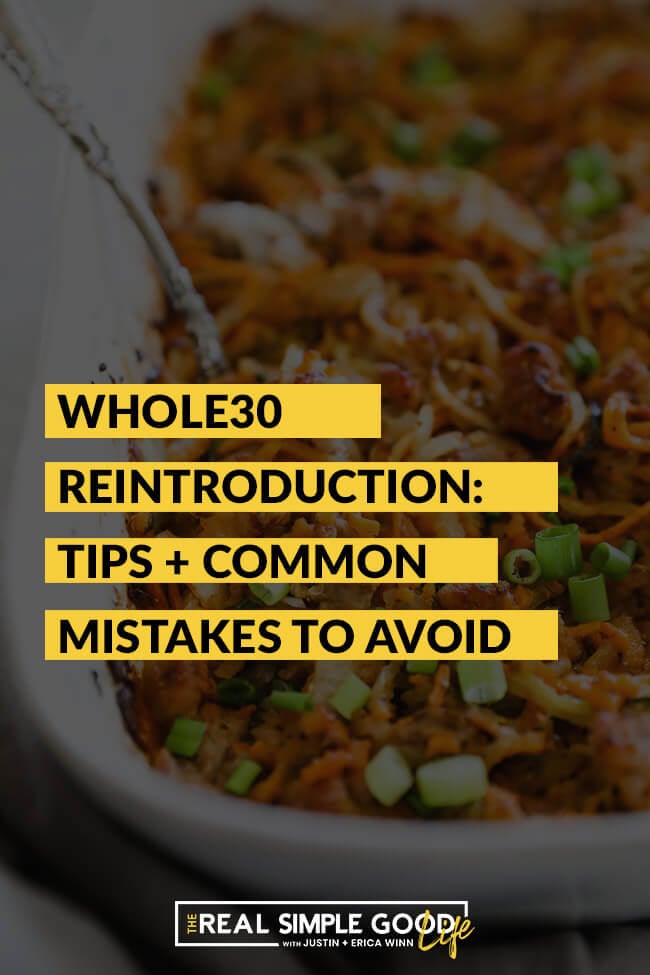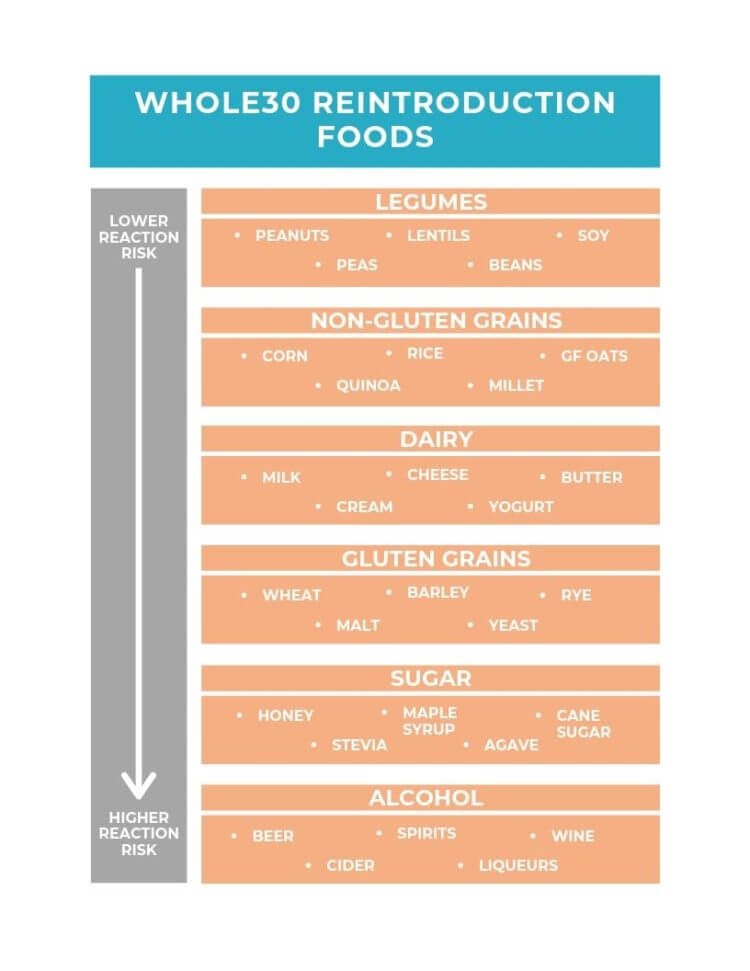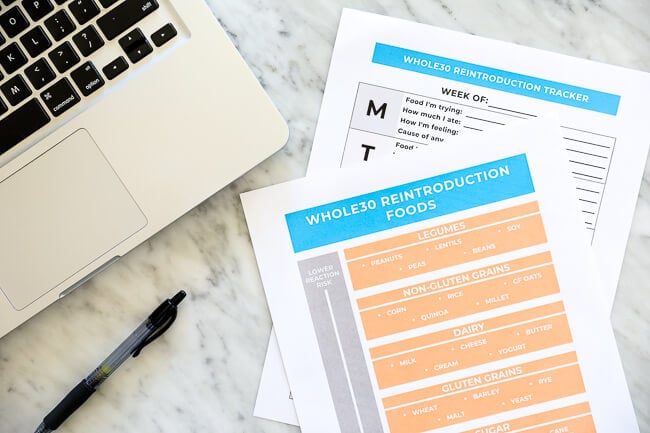Tough love
It would be easy to just say hooray – I did a Whole30, and I feel great! Now I can go back to eating how I did before. But seriously, really!?! You just spent an entire 30 days cleaning your body out, bringing it back toward balance, and you want to just crap all over that by shoving your face with all the cheese, wine, grains and gluten?! What a waste of your Whole30. Don’t do that. It might seem like the 30 days of your Whole30 are important, and they are, but the reintroduction phase is really, really important. So, take it seriously. And if you happen to need to go through a Whole30 again, consider using one of our free meal plans! They’re comprehensive and include all the recipes you’ll need, weekly shopping lists and easy to follow prep and cook steps with lots of tips and tricks along the way.
So…what is this Whole30 reintroduction you speak of?
The Whole30 reintroduction is a post elimination phase where you slowly (let me say that again, SLOWLY) add back potentially allergenic foods to your diet. You do this systematically so you can identify which specific foods cause issues for you. We are all different and have different reactions to various foods, so this process helps to identify the unique needs of your own body. The goal of Whole30 is not to eliminate all the foods forever, but instead it is to eliminate the most allergenic foods for a period of time, so that you can REINTRODUCE them and actually feel how they affect your body. Sounds easy, right?! Well, yes and no. The reason you want introduce each category of foods slowly is that our bodies don’t always have an instant reaction to the food. Sometimes it can take up to 4 days for your body to show signs of a reaction to a particular food. So, if you move too fast through your reintroduction, it will be hard to know which foods are giving you issues.
Why you want to reintroduce slowly
Here’s an example: Let’s say the day after you finish your Whole30 you reintroduce legumes and things seem ok, so the next day you reintroduce non-gluten grains and things seem ok again. You’re thinking things look good and you must A-OK with these foods. You amp things up the next day, and you introduce dairy. And that day you feel like crap. Sooo….was it the dairy then? Maybe, but it also could have been a more delayed reaction to either the non-gluten grains or the legumes. It’s hard to say. Can you see how it muddies the waters if you move too quickly? The Whole30 website recommends a certain order for reintroducing food groups, and it is based on what foods are potentially least inflammatory to most inflammatory. So you start with the “safest” foods and work your way down the list to see how your body responds. Here’s the order the folks at Whole30 recommend for reintroduction.
LegumesNon-gluten grainsDairyGluten-containing grains
But sugar and alcohol aren’t on that list – what about those?
There are a couple of thoughts we have on sugar and alcohol. First, we think you can loosen up a little on sugar after you get through the reintroduction of the above items. Our personal approach to sugar is this…we might use honey, maple syrup or coconut sugar in a recipe here and there at home. Or maybe we might indulge in a treat sometimes that has some natural sweeteners in it. In addition, we might go out to dinner and not worry about added sugar in a sauce or dressing. Generally though, we aim for no refined sugar to the extent we can control it, and we don’t eat out that often where it is out of our control. We both feel better when we minimize sugar, so we go with it. Alcohol is another one where we know we feel better when we are smart about it. We advise only adding alcohol back in IF you really actually want a drink, and after you get through the foods. We do our best to get quality, no added sugar wines from brands that are grown organically or biodynamically – Dry Farm Wines is a great option. These wines have the least amount of sugar and toxins, which makes them healthier. Justin will sometimes drink cocktails at home or at a restaurant, but he just has a clear hard alcohol, like tequila or vodka, with sparkling water and a lime. I’m not a huge drinker, so really this one isn’t hard for me. If I want a drink I have one and move on, knowing that I don’t drink often.
But do I have to reintroduce all the foods?
Sometimes you just feel so great at the end of a Whole30 that you don’t necessarily want to add back a certain food group. For us, that is gluten. We both feel amazing when we don’t do gluten, so our hard line is that we always stay gluten-free at a very minimum. So, the answer here is NO. You do not have to reintroduce every food. If you have no interest in adding something back in, you can definitely continue to stay gluten-free or dairy-free, etc. The goal here is to tailor your lifestyle to allow the things you enjoy, that don’t give you issues or reactions and to ditch the things that just plain don’t work for you body. So, let’s get to it with some tips for a successful Whole30 reintroduction.
Tips for having your best Whole30 reintroduction
Ok, here are some tips for making the most of your reintroduction.
Test the foods you actually want to add back in – start slow, with the least likely to be offensive food groups (as noted above), and then fine tune it even further so you test the actual foods you want/hope to add back in. For me, this would look like starting with legumes – specifically lentils and beans because sometimes I like to add these in for a different source of protein and fiber. I’d also test peanuts because peanut butter is nice to have every once in a while. Test each specific food separately with enough time in between so you can get a sense of any issues you may have with them. Use a tracker – we created this Whole30 Reintroduction Tracker to note what you’re trying, how you’re feeling and any symptoms that occur. Keeping a diary like this is how I realized certain dairy gives me headaches. Slow and steady wins the race – we recommend waiting 3-4 days before trying a new food. This should be enough time for even a delayed reaction to set in. Keep taking notes each day, so you can attribute any symptoms to which foods caused them. On the days in between trying new foods go back to eating Whole30 – go back to eating Whole30 while you wait and assess each new food over the 3-4 days between trials, so you can be sure it was the food you tested that is ok or doesn’t jive with your body.Make a plan – map out what specific foods you want to try and put them on the calendar. Then, stick to it. See your reintroduction through, so you can have real food freedom. The ultimate goal is for you to add back in all the foods that you enjoy that work ok for your body. You won’t figure it out and be able to apply it going forward if you don’t take the time and effort to go through the reintroduction period. Lastly, as noted above – you don’t have to reintroduce all the foods. If you feel great and have no interest in a certain food group or specific food, you can absolutely carry on without reintroducing.
Common mistakes to avoid
Here are some common mistakes we hear people making that you’ll want to avoid.
Binging on several foods – sometimes people are so excited they finished their Whole30 that the first thing they do is “celebrate” by going out and binging on all the foods. This typically results in a “hang-over” from all the foods, drinks, sugar, etc. By doing this, it completely muddies the waters, you’ll have no idea what food caused what symptom, and you’ll basically need to go back to Whole30 eating for a week or so before you can really get to reintroducing foods properly. In our opinion, it’s not worth it. Not reintroducing foods you like – if there’s a food you love, and it adds joy to your life to have it, try reintroducing it. You may find some foods just don’t work for your body and are best to avoid, but you should definitely at least try adding back in the foods you love. The goal is to find YOUR perfect eating plan.Introducing foods too quickly – if you don’t wait the 3-4 days between reintroductions, it will make it hard to know which foods are causing which symptoms. Slow and steady wins the race. Not keeping notes – it’s hard to remember what you tried and how many days it’s been. If you don’t keep some sort of notes or tracking, it will make it harder to see what foods work and don’t work for you. Here’s the Whole30 Reintroduction Tracker we created.
What if the top allergens aren’t my issue?
If you go through your Whole30 and a successful reintroduction, but still seem to feel off or like something isn’t digesting well, the top allergens may not be your individual issue. For me, potatoes are my nemesis. I’ve tried eliminating and reintroducing several times, and they just don’t work for me. Here are some tips for troubleshooting.
Other possible culprits to consider – nightshades, eggs, nuts, high-FODMAP foods, onion, garlic. Follow your intuition – if you suspect a certain food is giving you issues, approach it like doing a Whole30, but just eliminating that specific food. I did this with eggs when I had an inkling they might be the root of some issues for me. I stopped eating them for a couple of weeks (you can try 2-4 weeks for elimination here) and then tried to reintroduce. Sure enough, I felt like crap when I tried to add them back in. Lesson learned. You can rinse and repeat this process for any foods you think might not serve you. Get outside help – if you really feel like you can’t figure out what foods aren’t working for you outside of the top allergens, work with a professional. Find a naturopath in your area, and do some additional testing and work to get to the root cause of your issues. I promise it’s worth it!
Alright, time to start your Whole30 reintroduction
We hope these tips and missteps to avoid are helpful. This is really the most powerful part of the Whole30 process, and definitely worth taking the time to work through to get to YOUR perfect eating plan. Have your end goals in mind, make a plan and track your progress! Leave a comment below to let us know how it goes and tag us in your reintroduction posts on Instagram @realsimplegood. Give us a follow if you don’t already, too – let’s stay connected! SHARE IT NOW OR PIN IT FOR LATER!



